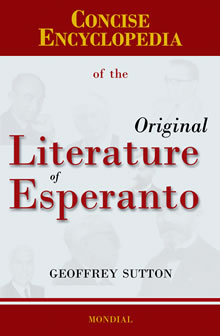


Geoffrey Sutton:
Concise Encyclopedia of the Original Literature of Esperanto
740 pages. Hardcover with jacket.
1. Book version: ISBN 9781595690906 or PayPal. 5 x 8 in (ca. 20 cm x 12.5 cm)
2. eBook version: Google Play
• a unique work of international reference
• an English-language companion for the literary enthusiast
• a 'must' for every serious library and media reference section
Reviews:
1. John Wells: A long kolego. In: Times Literary Supplement (Times, London: February 6, 2009): 2 page review.
Click to see as PDF (1.5 MB).
2. Sir Peter Stothard (editor of the Times Literary Supplement) on February 12, 2009, on ABC Radio National,
about Sutton's encyclopedia and Esperanto in general.
Click to listen in or right-click to download (mp3 - 4MB).
Original (complete show) at: http://www.abc.net.au/rn/bookshow/stories/
2009/2489339.htm.
TO SEE ALL OF OUR BOOKS IN AND ABOUT ESPERANTO: www.esperantoliteraturo.com
This outstanding work of scholarly reference appears in English for the first time. No other such extensive descriptive work is available on this global cultural phenomenon. Esperanto is the only planned international language to have become the vernacular and literary medium of a widespread speech community. This work charts the evolution of its original literature from its humble beginnings in 1887 to its worldwide use in every literary genre in the present day. The work is a revelation for students of comparative and world literature.
The Concise Encyclopedia of the Original Literature of Esperanto contains:
• a preface by Dr. Humphrey Tonkin, Professor of the Humanities and President Emeritus at the University of Hartford, Connecticut
• a general introduction to Esperanto literature, its history, evolution and modern development
• individual introductions to the five periods of the literature
• over 300 individual articles on the most important writers and their work in chronological order, with biographies and critique
• sample literary texts from some of the best original authors
• an introduction to the language itself, its linguistic structure and creative capabilities
• extensive bibliographies and index
Esperanto is used on every continent as a neutral second language by people who wish to practise
mutual respect for other cultures – and not merely advocate it. It has evolved naturally into a fully
developed literary language, whose acquisition nevertheless does not necessitate the many years of
study required by an ethnic language.
Esperanto literature is created by writers from many countries who have chosen to use it because
of its merits. It is, as yet, nearly always a labour of love – that is to say a product of culture. It is also
most fundamentally democratic – a product of people, as opposed to capital, power or national
prestige. More generally, the precise nature of Esperanto culture is still debated. It is certain, however,
that it is unusually aware. In contrast to other contemporary cultures, Esperanto-speakers are
more likely to be acquainted with their poets, despite the lack of a state-financed education system.
The beginnings of the philosophy behind Esperanto may be found in the work of Descartes. This
philosophy is the concretization of an ideal that has been incubated by enlightened people for
centuries: If all our mental processes and operations should be ruled by reason, then the first field into
which we must introduce it is that means by which we express and interconnect our thoughts, which is
language. (Gaston Waringhien).
Leibnitz continued the work of Descartes. At the end of a French-language manuscript, discovered
in Hanover Library in 1903, he wrote: When this project (of a universal language) is realized, the
happiness of mankind will depend solely on themselves, because then they will have a tool at their disposal
that will serve to increase their good sense as the telescope serves to increase the capacity to see …
Esperanto is a vernacular and literary medium that belongs equally to all and to no one, used by
people who are universally bilingual or multilingual and generally support language diversity.
